A banana tree from the family of the same name is a perennial herb plant that grows in a tropical or subtropical climate. In temperate latitudes, the culture, also known as pawpaw paw, or paw pau, can often be found on potted windowsills, especially in the apartments of exotic lovers.
Material Content:
- 1 Banana tree - varieties for the house
- 2 Features of home growing
- 3 Obtaining and germinating seeds from a purchased banana
- 4 Azimine Triloba Seed Planting Guidelines
- 5 Planting a plant in a permanent place
- 6 Caring for a Potted Banana Tree
- 7 Pest and Disease Control
- 8 Flowering and fruiting of a banana tree
- 9 Plant propagation
- 10 Possible growing difficulties
Banana tree - varieties for the house
In the wild, the genus has about several dozen species. At home, decorative and fruit bananas are grown, while there are two more groups - fodder and technical.
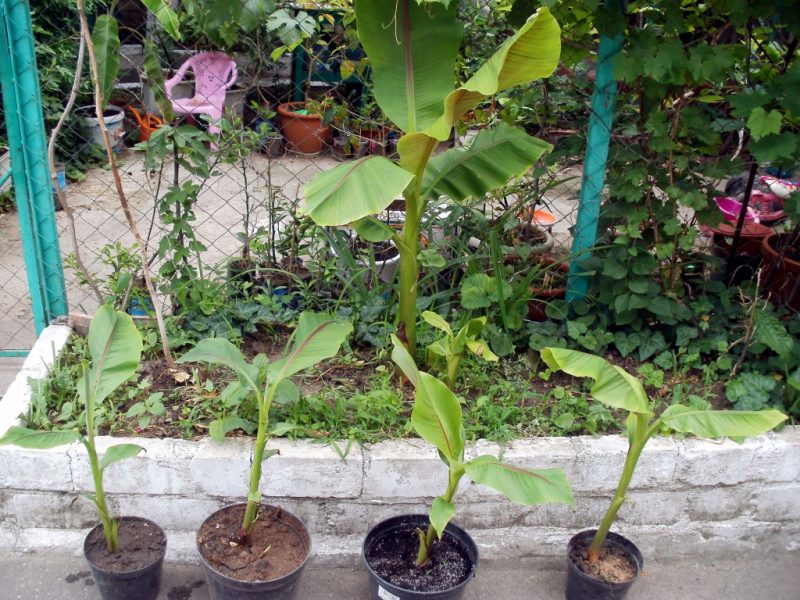
Among the fruit varieties, the breeding of most of which the American breeders worked on, stand out:
- “Davis” is a variety with high quality fruits that have yellow, sweet flesh.
- “Martin” is a cold-resistant variety.
- "Sochinskaya 11" - tall plants of domestic variety can form tasty fruits of early ripening, weighing up to 350 g.
Representatives of tropical flora with high decorative qualities and inedible fruits are often used in landscaping.
To achieve the best result, phytodesigners focus on such varieties as:
- The banana is velvet. Spectacular undersized plant, distinguished by beautiful flowers, painted in bright yellow color, with scarlet bracts. The name of the culture is due to the velvety surface of the fruit.
- Banana lavender. High decorative qualities are distinguished by lavender, orange or pink flowers, shaded by bright green foliage.
- Banana is bright red. Variety with contrasting scarlet inflorescences captivating the eye.
Features of home growing
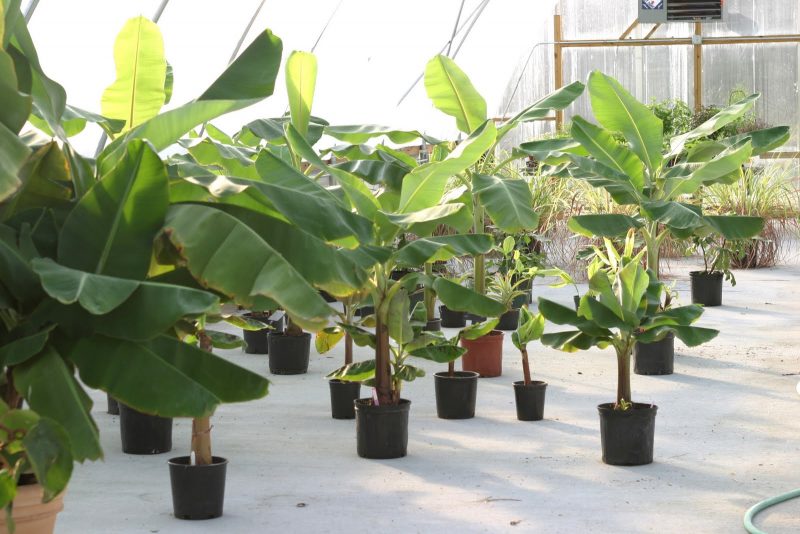
When cultivating a banana tree as a pot culture, it is necessary to take into account its botanical features:
- Height. In an apartment environment, the average height of plants is 2.5 m, and a dwarf banana tree does not grow above one and a half meters.
- Leaf plates. The length of the leaves forming the pseudo-trunk due to the dense diligence of their bases reaches 2 m.
- Stem. The vegetative organ is underground, performing the functions of the rhizome.
- Inflorescences. They are formed on peduncles developing from the center of a pseudostem, dying off after ripening of fruits.
Obtaining and germinating seeds from a purchased banana
Banana tree seeds can be obtained from a fruit purchased at a grocery store.
For this:
- A ripe banana is placed in a bag for a while.
- When the peel is completely darkened, the banana is peeled and cut along with a sharp and disinfected tool.
- Rounded seeds are extracted from the core of the fruit and laid out one by one on paper.
- The seed is washed, after which it is poured with warm water and left for 3 days.
- After extraction, the seeds are washed again and thoroughly dried.
When the florist receives the finished seeds, you can begin to germinate them, which will allow you to get shoots of an exotic plant much earlier.
Seed is germinated as follows:
- A substrate is prepared from sand and peat in a ratio of 3: 1.
- At the bottom of the box is placed drainage material.
- From above, the drainage is covered with a 6 cm layer of substrate.
- Seeds with a pre-scratched shell are pressed into the ground.
- After watering, the container is covered with a film to create greenhouse conditions with high temperature and humidity.
- After 3 days, the seeds should cling.
Azimine Triloba Seed Planting Guidelines
Also, seed can be purchased at a flower shop, especially for decorative plant species.

But regardless of the method of obtaining it, there are a number of general recommendations that should be followed when sowing seeds that have already bent over:
- Small diameter pots are taken.
- At the bottom of each tank is placed a drainage layer, which is sprinkled with a layer of wet sand.
- The soil mixture, calcined in the oven, is poured from the soil from birch, sand, humus and ash in a proportion of 10: 2: 1: 0.5.
- Germinated seeds are deepened by 2 cm, after which the soil is moistened.
Planting a plant in a permanent place
After exotic perennials get stronger, they should be planted in pots for adult plants.
Pot selection

Due to the intensive growth of the herbaceous plant and the peculiarities of its structure, a spacious pot with good drainage is selected for the representative of the tropics, which does not allow water to stagnate in the roots and prevents the development of a fungal disease.
Soil requirement
A banana tree grows well in fertile, loose soil with a neutral or slightly acidic reaction. With self-preparation, the soil mixture is composed of sod, humus and leaf soil, as well as sand in a ratio of 2: 2: 2: 1.
Caring for a Potted Banana Tree
In order for the plant not only to please the grower with beautiful greens and flowers, but also to bear fruit annually, it is necessary to carry out regular comprehensive care.
Temperature, lighting and location
Photophilous culture needs an abundance of light and a long daylight.
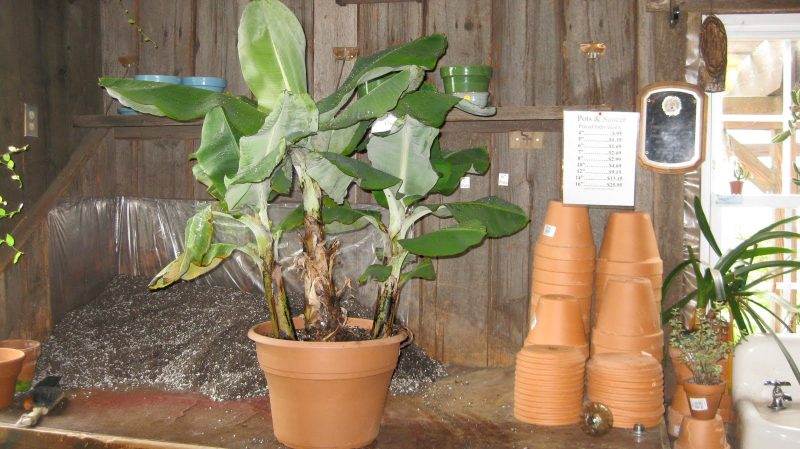
When placing it in an apartment, preference should be given to southern windows, since a banana tree is not afraid of the open sun. In the autumn-winter period of time, when the nights become longer, the culture is organized afterlighting using fluorescent lamps.
The thermophilic plant will be able to realize its potential at temperatures from 24 to 30 ° C.
Important! The maximum permissible value below which the temperature should not fall is 16 ° C.
Watering and humidity
A low level of humidity is detrimental to the plant, which is manifested by the loss of gloss of leaves, which subsequently dry out. To maintain an optimum level of humidity, a banana tree is sprayed daily or mounted on a pallet with wet pebbles. Another additional measures to preserve the decorative effect are the systematic wiping of the sheet plates with a damp sponge and the organization of a warm shower.
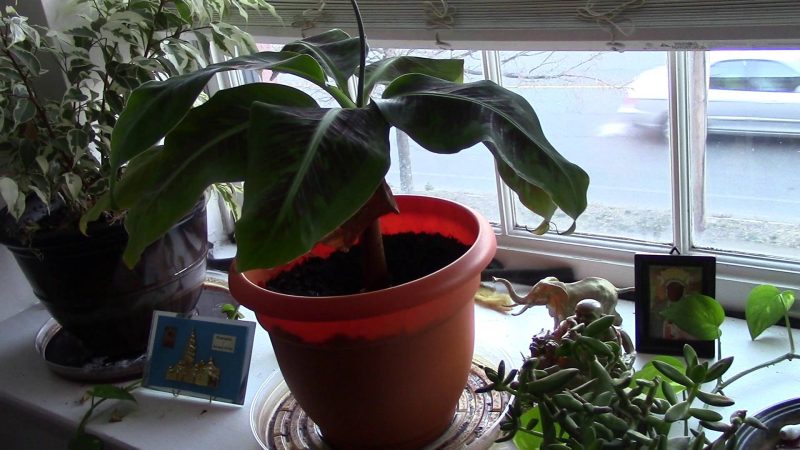
Abundant watering, in which the earthen lump should constantly be in a slightly moistened state, is an integral part of comprehensive care, which makes it possible to grow a healthy plant. With the advent of the fall season, the amount of moisture is gradually reduced.
Attention! For irrigation, only warm, soft water without chlorine is used.
Fertilizer and fertilizer
Indoor banana tree is fed twice a month for intensive growth. For top dressing, liquid mineral fertilizers with a high concentration of phosphorus and potassium in the composition are used. Also, the fertility of the substrate can be maintained by applying organic fertilizers.
Banana tree pruning
Tropical culture does not need pruning, independently forming a lush crown.
Comfortable conditions in the winter
In winter, the banana stops the active vegetation and moves to a cooler place, away from heating appliances. During this period, watering is reduced, feeding is not carried out, and the moisture level is maintained only with the help of wet pebbles in the pan.
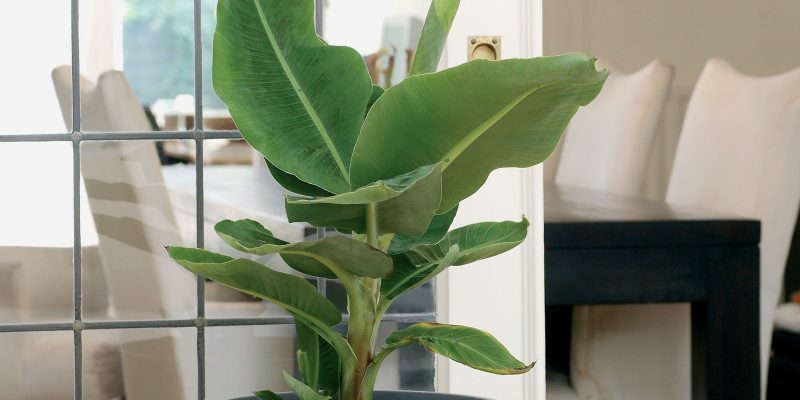
Transfer
Every spring a transplant is carried out, in which:
- A more capacious pot is selected, the space of which will be enough for a rapidly developing root system throughout the year.
- A drainage layer is placed at the bottom.
- Drainage is sprinkled on top with a nutritious, loose substrate.
- Banana tree is transshipped and sprinkled with soil.
- The root neck is slightly buried in the substrate.
Pest and Disease Control
Subject to the correct watering regime, an exotic plant does not suffer from diseases. However, with excess moisture and its stagnation in the roots, the development of gray rot is possible, which can be stopped by timely removal of the affected parts of the root system and its transplantation into a fresh substrate.
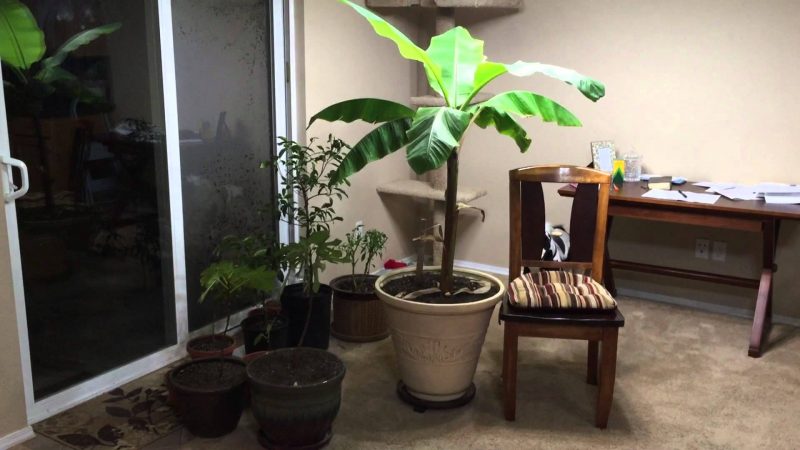
Of the pests, a banana tree can be populated by a spider mite, thrips, scab, mealybug and aphid, which should be controlled with an insecticidal solution.
As a preventive protective measure, the necessary level of air humidity should be maintained and the plant should be given a warm shower.
Flowering and fruiting of a banana tree

After the banana has developed sufficiently, when 18 full leaf plates are formed on it, the flowering phase is observed, lasting from 3 to 12 months. This period is characterized by the development of racemose inflorescence, gradually dropping. The fruits that have formed in place of the flowers ripen in tiers - from top to bottom.
Plant propagation
At home, the propagation of the culture is carried out in two ways - by seeds and lateral offspring (children). The seed method described above is more time consuming and lengthy. Therefore, if the grower already has an adult copy, then the preference should be given to the vegetative method of breeding.
Side offspring

In the early spring during a transplant, the following actions are carried out:
- Using a sharp tool, the cuttings with part of the rhizome are separated from the adult instance.
- The place of cut is sprinkled with crushed wood or activated carbon.
- The baby is buried in a small container with a drainage layer and a substrate of peat and sand in equal parts.
Possible growing difficulties
Growing a banana tree in an apartment environment may be accompanied by such difficulties:
Yellowing leaf plates
If the bright green begins to turn yellow, then there may be several reasons:
- The lack of light that a banana tree needs in large quantities. Moreover, even direct sunlight does not harm an exotic plant.
- An excess of moisture and the beginning of the development of gray rot.
- Subcooling when the mercury column drops below 16 ° C.
- Population of shoots by sucking insects that feed on the juice of leaf blades.
Leaf tips dry
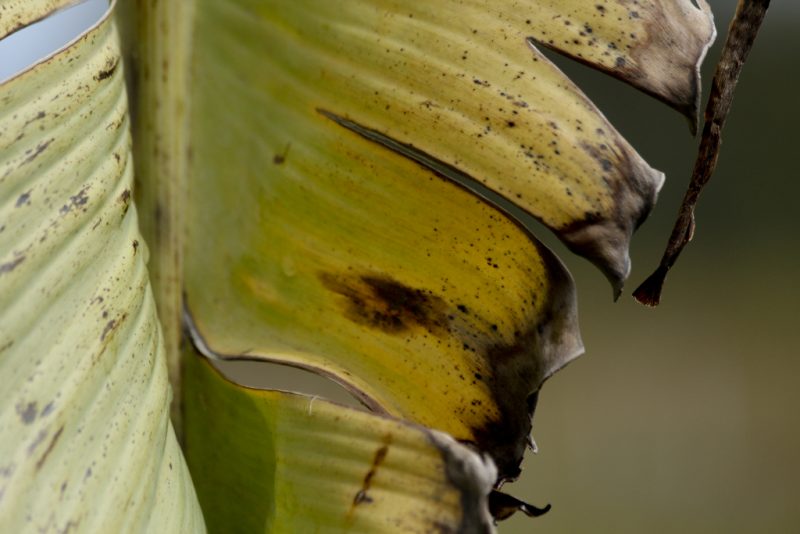
The occurrence of the problem is associated with soil and air drought, which will help to cope:
- Abundant irrigation with settled water at room temperature.
- Systematic spraying and placement of a herbaceous plant on a pallet with moistened pebbles or expanded clay.
Thus, even a novice amateur can grow a banana tree at home if all the requirements for the maintenance and care of a representative of the tropical flora are observed. And most importantly, self-grown fruits will be much tastier, as the store sells green bananas ripening in the ripped form.












